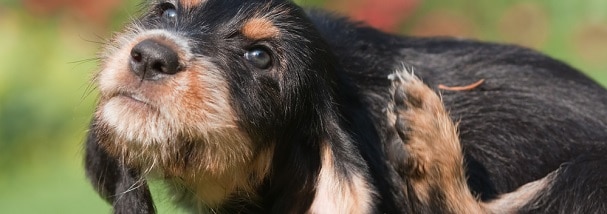 A question we commonly hear is, "My dog has dry itchy skin. He occasionally gets rashes, bumps or hot spots. What can I do?"
A question we commonly hear is, "My dog has dry itchy skin. He occasionally gets rashes, bumps or hot spots. What can I do?"
There are many reasons why a dog has dry itchy skin, below is a list of different problems and the way to treat and prevention.
Ectoparasites - such as fleas, mites and lice
Fleas are very small wingless insects that jump, they are red/ brown in colour and feed on the blood of your dog. The flea can sometimes cause irritation due to their bite/ or because of an animal's allergic reaction to the flea's saliva. Dogs and cats both have lice, each has its own species. They do not cross-contaminate, they are very small but can be seen by the human eye, and they are very slow moving to easy to spot.
Sarcoptic mange from mites found on urban foxes can cause your dog to itch like crazy - but it's very hard to diagnose as they burrow deep into the skin. Signs to look out for are hair loss and inflamed skin with small scabs.
Fleas are best treated with a good flea control from your vets. It should be applied every month, making sure that all the animals in the house are being treated, and also cleaning their bedding, soft furnishings and carpets with a good environmental spray, as they can be a good harbour for fleas' eggs.
Regularly grooming your dog can be helpful too.
Atopic dermatitis
This is the most common allergy found in dogs because it is caused by house dust mites and pollen.
Your dog can get atopic dermatitis from about 6 months old. You may notice itching of the face, ears and feet.
What to look out for is pinky/brown staining of the fur which is caused by the mix of the dog's saliva and the materials for yeast and bacteria.
Allergies are lifelong for your dog but can be managed with treatments that you can get from your vet.
Food allergies
Food allergies mainly affect dogs, but cats can have them too.
The food allergy can happen at any stage in your dog's life and are not linked to sudden change in diet, they can just become allergic to a food that they have been eating all their life.
To see if your dog has a food allergy your vet may suggest doing a food trial – so gradually eliminate certain foods from your pet's diets over 12 weeks and then slowly reintroduce them one at a time.
Infections - bacteria or yeast
In most cases the infection is secondary to something else. Bacterial infections occur where the skin is damaged through scratching or in hot sweaty skin folds, when yeast infections occur with other skin problems.
Bacterial infections are normally red, weeping wounds, fur loss and yeast infections are red, greasy skin, scaly spots and also you may smell a funny yeasty smell.
Your vet will be able to treat with antibiotics or topical treatments depending if it is a bacterial or yeast infection.
Tips to keep your pet itch free:
- Keep up with regular flea treatments (from your vets)
- Make sure you are feeding them a good quality food
- Groom your dog regularly
- Making sure the home environment is clean and using environmental sprays for fleas and dust mites
- Not to wash your dog to often as it washes out their natural oils
- Giving oil supplements if you know your animal has got scaly skin - such as salmon oil, or cod liver oil
Contact us for more information or if you suspect your dog has a skin infection.


